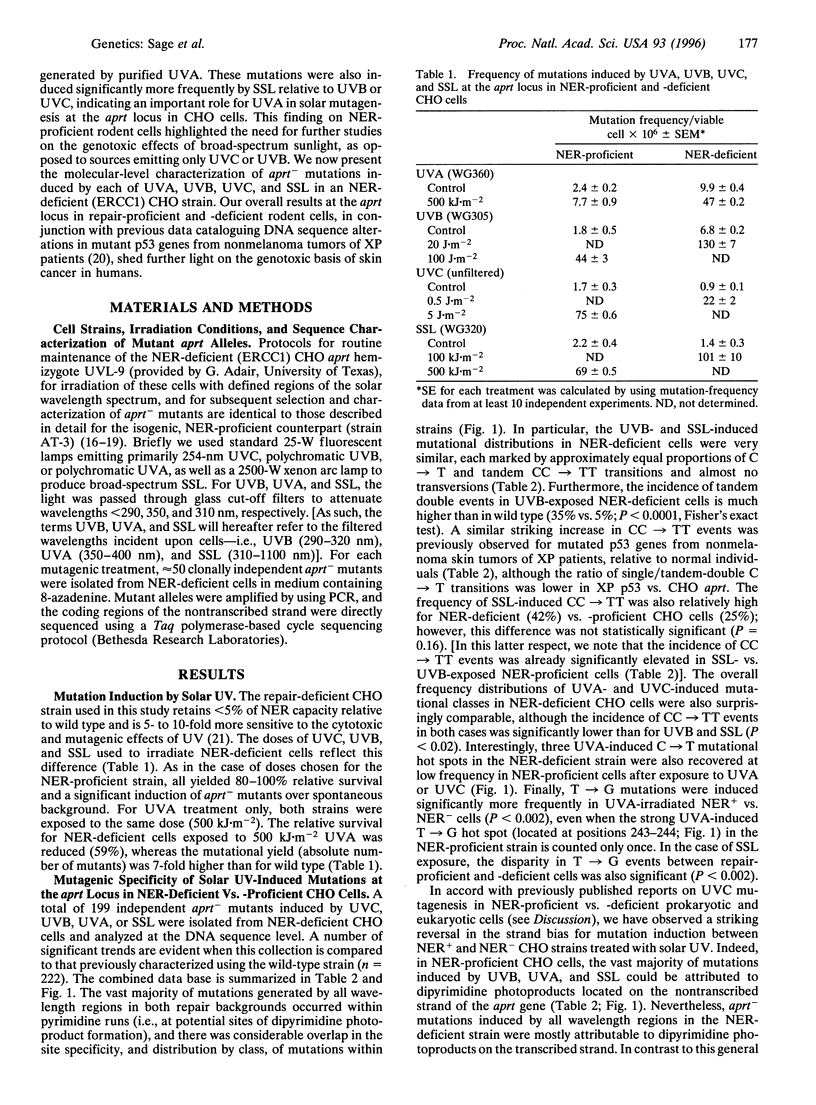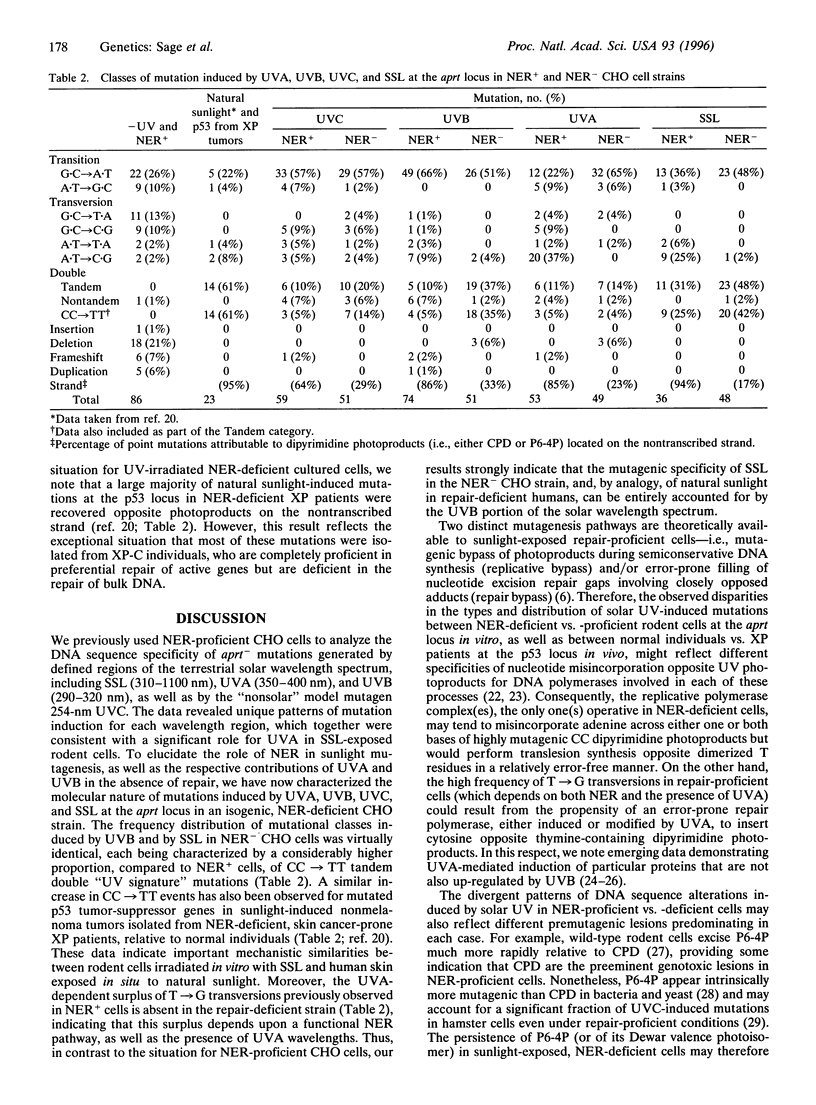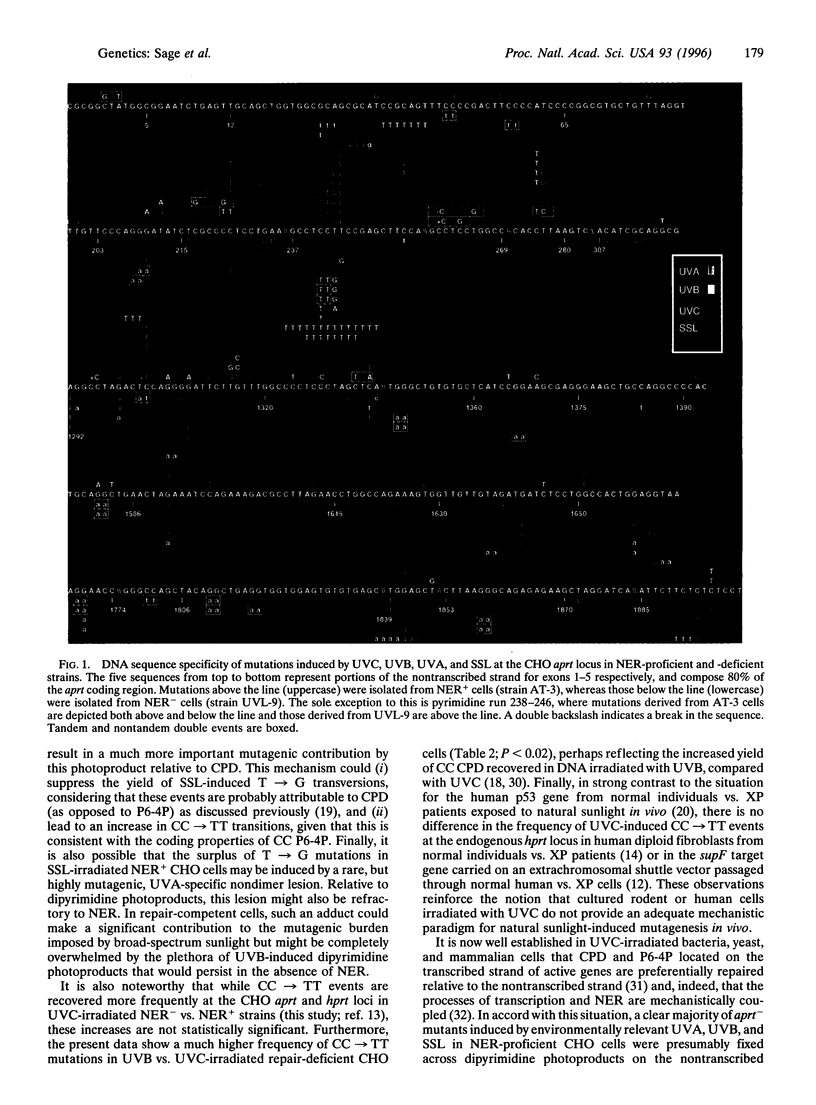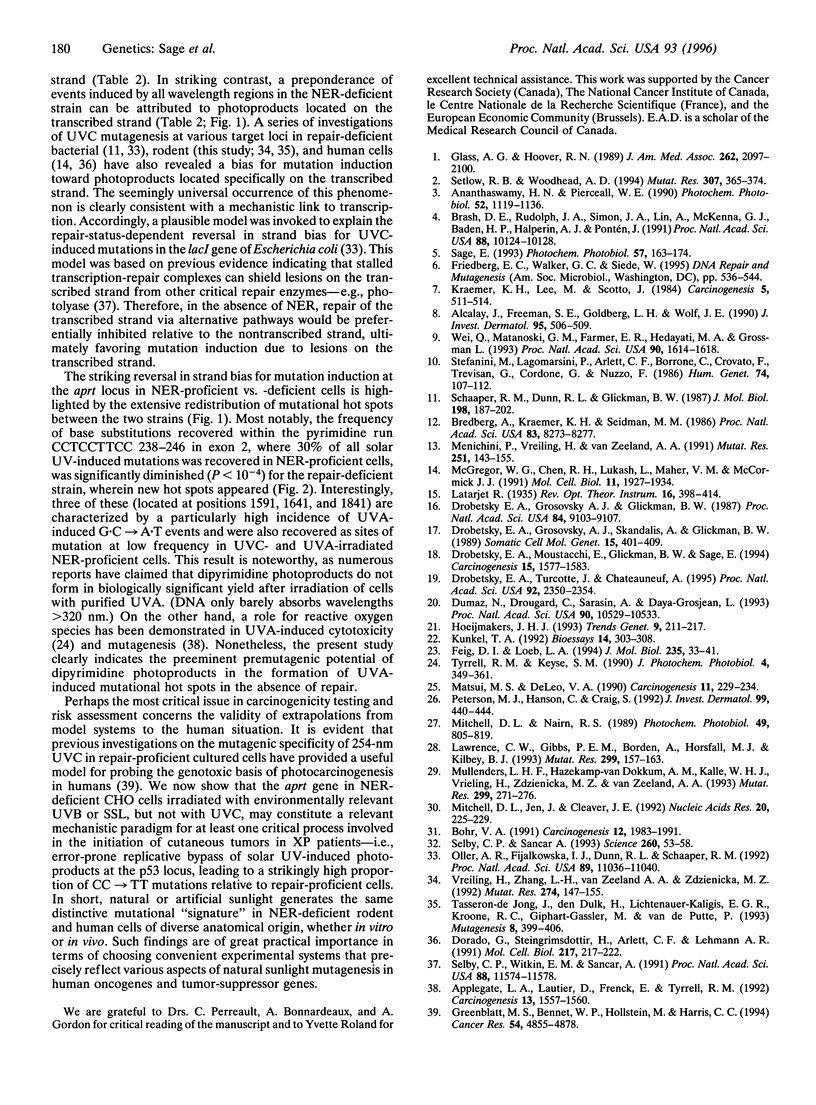Abstract
To investigate the role of nucleotide excision repair (NER) in the cellular processing of carcinogenic DNA photoproducts induced by defined, environmentally relevant portions of the solar wavelength spectrum, we have determined the mutagenic specificity of simulated sunlight (310-1100 nm), UVA (350-400 nm), and UVB (290-320 nm), as well as of the "nonsolar" model mutagen 254-nm UVC, at the adenine phosphoribosyltransferase (aprt) locus in NER-deficient (ERCC1) Chinese hamster ovary (CHO) cells. The frequency distributions of mutational classes induced by UVB and by simulated sunlight in repair-deficient CHO cells were virtually identical, each showing a marked increase in tandem CC-->TT transitions relative to NER-proficient cells. A striking increase in CC-->TT events was also previously documented for mutated p53 tumor-suppressor genes from nonmelanoma tumors of NER-deficient, skin cancer-prone xeroderma pigmentosum patients, compared to normal individuals. The data therefore indicate that the aprt gene in NER-deficient cultured rodent cells irradiated with artificial solar light generates the same distinctive "fingerprint" for sunlight mutagenesis as the p53 locus in NER-deficient humans exposed to natural sunlight in vivo. Moreover, in strong contrast to the situation for repair-component CHO cells, where a significant role for UVA was previously noted, the mutagenic specificity of simulated sunlight in NER-deficient CHO cells and of natural sunlight in humans afflicted with xeroderma pigmentosum can be entirely accounted for by the UVB portion of the solar wavelength spectrum.
Full text
PDF




Images in this article
Selected References
These references are in PubMed. This may not be the complete list of references from this article.
- Alcalay J., Freeman S. E., Goldberg L. H., Wolf J. E. Excision repair of pyrimidine dimers induced by simulated solar radiation in the skin of patients with basal cell carcinoma. J Invest Dermatol. 1990 Nov;95(5):506–509. doi: 10.1111/1523-1747.ep12504707. [DOI] [PubMed] [Google Scholar]
- Ananthaswamy H. N., Pierceall W. E. Molecular mechanisms of ultraviolet radiation carcinogenesis. Photochem Photobiol. 1990 Dec;52(6):1119–1136. doi: 10.1111/j.1751-1097.1990.tb08452.x. [DOI] [PubMed] [Google Scholar]
- Applegate L. A., Lautier D., Frenk E., Tyrrell R. M. Endogenous glutathione levels modulate the frequency of both spontaneous and long wavelength ultraviolet induced mutations in human cells. Carcinogenesis. 1992 Sep;13(9):1557–1560. doi: 10.1093/carcin/13.9.1557. [DOI] [PubMed] [Google Scholar]
- Brash D. E., Rudolph J. A., Simon J. A., Lin A., McKenna G. J., Baden H. P., Halperin A. J., Pontén J. A role for sunlight in skin cancer: UV-induced p53 mutations in squamous cell carcinoma. Proc Natl Acad Sci U S A. 1991 Nov 15;88(22):10124–10128. doi: 10.1073/pnas.88.22.10124. [DOI] [PMC free article] [PubMed] [Google Scholar]
- Bredberg A., Kraemer K. H., Seidman M. M. Restricted ultraviolet mutational spectrum in a shuttle vector propagated in xeroderma pigmentosum cells. Proc Natl Acad Sci U S A. 1986 Nov;83(21):8273–8277. doi: 10.1073/pnas.83.21.8273. [DOI] [PMC free article] [PubMed] [Google Scholar]
- Dorado G., Steingrimsdottir H., Arlett C. F., Lehmann A. R. Molecular analysis of ultraviolet-induced mutations in a xeroderma pigmentosum cell line. J Mol Biol. 1991 Jan 20;217(2):217–222. doi: 10.1016/0022-2836(91)90533-c. [DOI] [PubMed] [Google Scholar]
- Drobetsky E. A., Grosovsky A. J., Glickman B. W. The specificity of UV-induced mutations at an endogenous locus in mammalian cells. Proc Natl Acad Sci U S A. 1987 Dec;84(24):9103–9107. doi: 10.1073/pnas.84.24.9103. [DOI] [PMC free article] [PubMed] [Google Scholar]
- Drobetsky E. A., Grosovsky A. J., Skandalis A., Glickman B. W. Perspectives on UV light mutagenesis: investigation of the CHO aprt gene carried on a retroviral shuttle vector. Somat Cell Mol Genet. 1989 Sep;15(5):401–409. doi: 10.1007/BF01534891. [DOI] [PubMed] [Google Scholar]
- Drobetsky E. A., Moustacchi E., Glickman B. W., Sage E. The mutational specificity of simulated sunlight at the aprt locus in rodent cells. Carcinogenesis. 1994 Aug;15(8):1577–1583. doi: 10.1093/carcin/15.8.1577. [DOI] [PubMed] [Google Scholar]
- Drobetsky E. A., Turcotte J., Châteauneuf A. A role for ultraviolet A in solar mutagenesis. Proc Natl Acad Sci U S A. 1995 Mar 14;92(6):2350–2354. doi: 10.1073/pnas.92.6.2350. [DOI] [PMC free article] [PubMed] [Google Scholar]
- Dumaz N., Drougard C., Sarasin A., Daya-Grosjean L. Specific UV-induced mutation spectrum in the p53 gene of skin tumors from DNA-repair-deficient xeroderma pigmentosum patients. Proc Natl Acad Sci U S A. 1993 Nov 15;90(22):10529–10533. doi: 10.1073/pnas.90.22.10529. [DOI] [PMC free article] [PubMed] [Google Scholar]
- Feig D. I., Loeb L. A. Oxygen radical induced mutagenesis is DNA polymerase specific. J Mol Biol. 1994 Jan 7;235(1):33–41. doi: 10.1016/s0022-2836(05)80009-9. [DOI] [PubMed] [Google Scholar]
- Glass A. G., Hoover R. N. The emerging epidemic of melanoma and squamous cell skin cancer. JAMA. 1989 Oct 20;262(15):2097–2100. [PubMed] [Google Scholar]
- Greenblatt M. S., Bennett W. P., Hollstein M., Harris C. C. Mutations in the p53 tumor suppressor gene: clues to cancer etiology and molecular pathogenesis. Cancer Res. 1994 Sep 15;54(18):4855–4878. [PubMed] [Google Scholar]
- Hoeijmakers J. H. Nucleotide excision repair. II: From yeast to mammals. Trends Genet. 1993 Jun;9(6):211–217. doi: 10.1016/0168-9525(93)90121-w. [DOI] [PubMed] [Google Scholar]
- Kraemer K. H., Lee M. M., Scotto J. DNA repair protects against cutaneous and internal neoplasia: evidence from xeroderma pigmentosum. Carcinogenesis. 1984 Apr;5(4):511–514. doi: 10.1093/carcin/5.4.511. [DOI] [PubMed] [Google Scholar]
- Lawrence C. W., Gibbs P. E., Borden A., Horsfall M. J., Kilbey B. J. Mutagenesis induced by single UV photoproducts in E. coli and yeast. Mutat Res. 1993 May;299(3-4):157–163. doi: 10.1016/0165-1218(93)90093-s. [DOI] [PubMed] [Google Scholar]
- McGregor W. G., Chen R. H., Lukash L., Maher V. M., McCormick J. J. Cell cycle-dependent strand bias for UV-induced mutations in the transcribed strand of excision repair-proficient human fibroblasts but not in repair-deficient cells. Mol Cell Biol. 1991 Apr;11(4):1927–1934. doi: 10.1128/mcb.11.4.1927. [DOI] [PMC free article] [PubMed] [Google Scholar]
- Menichini P., Vrieling H., van Zeeland A. A. Strand-specific mutation spectra in repair-proficient and repair-deficient hamster cells. Mutat Res. 1991 Nov;251(1):143–155. doi: 10.1016/0027-5107(91)90224-c. [DOI] [PubMed] [Google Scholar]
- Mitchell D. L., Jen J., Cleaver J. E. Sequence specificity of cyclobutane pyrimidine dimers in DNA treated with solar (ultraviolet B) radiation. Nucleic Acids Res. 1992 Jan 25;20(2):225–229. doi: 10.1093/nar/20.2.225. [DOI] [PMC free article] [PubMed] [Google Scholar]
- Mitchell D. L., Nairn R. S. The biology of the (6-4) photoproduct. Photochem Photobiol. 1989 Jun;49(6):805–819. doi: 10.1111/j.1751-1097.1989.tb05578.x. [DOI] [PubMed] [Google Scholar]
- Mullenders L. H., Hazekamp-van Dokkum A. M., Kalle W. H., Vrieling H., Zdzienicka M. Z., van Zeeland A. A. UV-induced photolesions, their repair and mutations. Mutat Res. 1993 May;299(3-4):271–276. doi: 10.1016/0165-1218(93)90103-k. [DOI] [PubMed] [Google Scholar]
- Oller A. R., Fijalkowska I. J., Dunn R. L., Schaaper R. M. Transcription-repair coupling determines the strandedness of ultraviolet mutagenesis in Escherichia coli. Proc Natl Acad Sci U S A. 1992 Nov 15;89(22):11036–11040. doi: 10.1073/pnas.89.22.11036. [DOI] [PMC free article] [PubMed] [Google Scholar]
- Petersen M. J., Hansen C., Craig S. Ultraviolet A irradiation stimulates collagenase production in cultured human fibroblasts. J Invest Dermatol. 1992 Oct;99(4):440–444. doi: 10.1111/1523-1747.ep12616142. [DOI] [PubMed] [Google Scholar]
- Sage E. Distribution and repair of photolesions in DNA: genetic consequences and the role of sequence context. Photochem Photobiol. 1993 Jan;57(1):163–174. doi: 10.1111/j.1751-1097.1993.tb02273.x. [DOI] [PubMed] [Google Scholar]
- Schaaper R. M., Dunn R. L., Glickman B. W. Mechanisms of ultraviolet-induced mutation. Mutational spectra in the Escherichia coli lacI gene for a wild-type and an excision-repair-deficient strain. J Mol Biol. 1987 Nov 20;198(2):187–202. doi: 10.1016/0022-2836(87)90305-6. [DOI] [PubMed] [Google Scholar]
- Selby C. P., Witkin E. M., Sancar A. Escherichia coli mfd mutant deficient in "mutation frequency decline" lacks strand-specific repair: in vitro complementation with purified coupling factor. Proc Natl Acad Sci U S A. 1991 Dec 15;88(24):11574–11578. doi: 10.1073/pnas.88.24.11574. [DOI] [PMC free article] [PubMed] [Google Scholar]
- Setlow R. B., Woodhead A. D. Temporal changes in the incidence of malignant melanoma: explanation from action spectra. Mutat Res. 1994 May 1;307(1):365–374. doi: 10.1016/0027-5107(94)90310-7. [DOI] [PubMed] [Google Scholar]
- Stefanini M., Lagomarsini P., Arlett C. F., Marinoni S., Borrone C., Crovato F., Trevisan G., Cordone G., Nuzzo F. Xeroderma pigmentosum (complementation group D) mutation is present in patients affected by trichothiodystrophy with photosensitivity. Hum Genet. 1986 Oct;74(2):107–112. doi: 10.1007/BF00282072. [DOI] [PubMed] [Google Scholar]
- Tasseron-de Jong J. G., den Dulk H., Lichtenauer-Kaligis E. G., Kroone R. C., Giphart-Gassler M., van de Putte P. Mutation induction by UV light in retroviral hprt cDNA integrated at various chromosomal positions in repair-deficient hamster cells. Mutagenesis. 1993 Sep;8(5):399–406. doi: 10.1093/mutage/8.5.399. [DOI] [PubMed] [Google Scholar]
- Tyrrell R. M., Keyse S. M. New trends in photobiology. The interaction of UVA radiation with cultured cells. J Photochem Photobiol B. 1990 Mar;4(4):349–361. doi: 10.1016/1011-1344(90)85014-n. [DOI] [PubMed] [Google Scholar]
- Vrieling H., Zhang L. H., van Zeeland A. A., Zdzienicka M. Z. UV-induced hprt mutations in a UV-sensitive hamster cell line from complementation group 3 are biased towards the transcribed strand. Mutat Res. 1992 Aug;274(2):147–155. doi: 10.1016/0921-8777(92)90061-7. [DOI] [PubMed] [Google Scholar]
- Wei Q., Matanoski G. M., Farmer E. R., Hedayati M. A., Grossman L. DNA repair and aging in basal cell carcinoma: a molecular epidemiology study. Proc Natl Acad Sci U S A. 1993 Feb 15;90(4):1614–1618. doi: 10.1073/pnas.90.4.1614. [DOI] [PMC free article] [PubMed] [Google Scholar]



